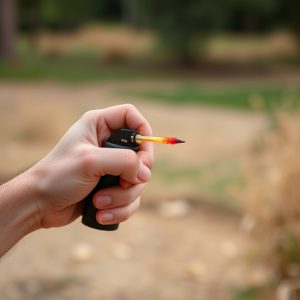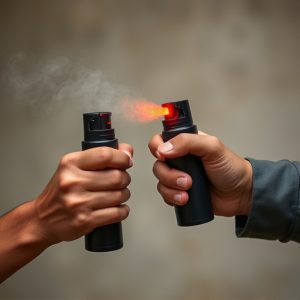Maximizing Pepper Spray Potency: Storage, Shelf Life, and Safety
Pepper spray is a popular self-defense tool with two main types: oleoresin capsicum (OC) and alterna…….
Pepper spray is a popular self-defense tool with two main types: oleoresin capsicum (OC) and alternative ingredient sprays. Unopened cans last 5 years, while opened containers have a shorter lifespan of 6-12 months. Critical factors affecting potency include capsaicin concentration, formulation, packaging, and spray pattern. For optimal performance, store pepper spray in cool, dry conditions, away from sunlight and heat sources, for up to 3 years unopened, and follow manufacturer instructions after opening.
Tactical pepper spray is a popular self-defense tool, but understanding its dynamics is crucial. This comprehensive guide explores various types of pepper spray and their uses, with a focus on deciphering ‘after opening’ shelf life indications. We delve into factors influencing potency, offering safety tips for storage, and ensuring optimal performance. By the end, you’ll be armed with knowledge to make informed decisions about your personal protection.
- Understanding Pepper Spray: Types and Uses
- Decoding the Shelf Life: What Does 'After Opening' Mean?
- Factors Affecting Pepper Spray Potency and Effectiveness
- Best Practices for Storage and Safety Tips
Understanding Pepper Spray: Types and Uses
Pepper spray is a popular self-defense tool known for its effectiveness in incapacitating an attacker temporarily, allowing users to escape or seek help. It works by causing pain and irritation in the eyes and respiratory system, leading to temporary blindness and difficulty breathing. Understanding the different types of pepper spray and their uses is essential when considering it as a personal defense mechanism.
There are two primary categories: oleoresin capsicum (OC) spray and pepper spray with active ingredients other than OC. OC spray, derived from chili peppers, is the most common and potent form. It’s known for its long-lasting effects and wide range of target areas. Other types may use ingredients like capsaecin or piperideine, offering alternatives for those with sensitivities to OC. The shelf life of pepper spray after opening varies; while unopened cans typically have a 5-year lifespan, opened containers usually last around 6 months to 2 years, depending on storage conditions.
Decoding the Shelf Life: What Does 'After Opening' Mean?
When it comes to tactical pepper spray for self-protection, understanding “after opening” on the shelf life label is crucial. This phrase often signifies a significant shift in the product’s viability. Unlike unopened containers that typically boast a shelf life ranging from 3 to 5 years, opened cans or bottles face a much shorter duration of effectiveness, usually around 6 to 12 months.
The reason for this disparity lies in how pepper spray interacts with the outside environment once its seal is broken. Exposure to air, moisture, and light can degrade the active ingredients, reducing the spray’s potency and impact. Therefore, users should be mindful of when their pepper spray was opened and ensure they replace it within the recommended timeframe to maintain its reliability in emergency situations.
Factors Affecting Pepper Spray Potency and Effectiveness
The potency and effectiveness of tactical pepper spray are influenced by several factors. One key aspect is the concentration of capsaicin, the active ingredient responsible for the burning sensation it causes. Higher concentrations mean more intense irritation and faster disorientation or incapacitation of an attacker. However, even with the same concentration, other elements come into play.
Another critical factor is the spray’s formulation and packaging. How the pepper spray is mixed and contained can impact its shelf life after opening. Exposure to air, sunlight, and heat can degrade the active ingredients, reducing their potency over time. Additionally, the spray pattern and distance it travels play a role in effectiveness; a narrow stream may be more precise but cover less area, while a wider mist provides better coverage but might not penetrate protective gear as well.
Best Practices for Storage and Safety Tips
When storing tactical pepper spray, keep it in a cool, dry place away from direct sunlight and heat sources. Always store it out of reach of children and pets. For optimal effectiveness, be mindful of the pepper spray shelf life after opening. Pepper spray typically has a shelf life of 2-3 years before expiration, but this can vary depending on the manufacturer’s guidelines. Once opened, it’s crucial to follow specific storage instructions provided by the manufacturer to ensure potency and safety.
To maximize the lifespan of your tactical pepper spray, avoid extreme temperature fluctuations and keep it sealed tightly when not in use. Never leave it in a locked glove compartment or exposed to constant moisture as these conditions can compromise its integrity. Regularly inspect the spray for any signs of damage, leakage, or discoloration, which could indicate reduced effectiveness.
Tactical pepper spray is a powerful self-defense tool, but understanding its shelf life and proper storage is crucial. Knowing that ‘after opening’ indicates a reduced potency highlights the importance of timely usage. By following best practices for storage, including keeping it in a cool, dry place away from direct sunlight, you can ensure maximum effectiveness when you need it most. Remember, staying informed about pepper spray’s shelf life and safety tips is key to maintaining your personal protection.


